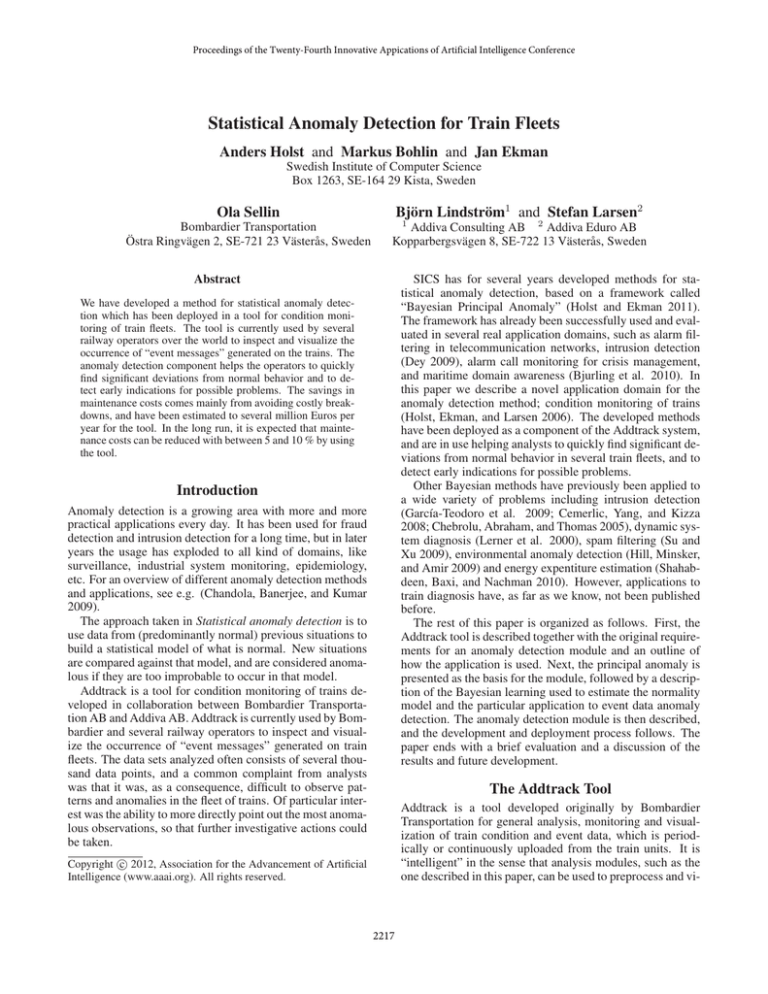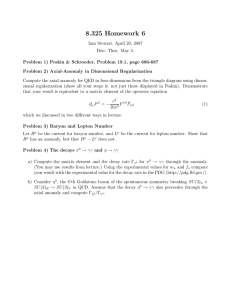
Proceedings of the Twenty-Fourth Innovative Appications of Artificial Intelligence Conference
Statistical Anomaly Detection for Train Fleets
Anders Holst and Markus Bohlin and Jan Ekman
Swedish Institute of Computer Science
Box 1263, SE-164 29 Kista, Sweden
Ola Sellin
Björn Lindström1 and Stefan Larsen2
Bombardier Transportation
Östra Ringvägen 2, SE-721 23 Västerås, Sweden
1
Addiva Consulting AB 2 Addiva Eduro AB
Kopparbergsvägen 8, SE-722 13 Västerås, Sweden
Abstract
SICS has for several years developed methods for statistical anomaly detection, based on a framework called
“Bayesian Principal Anomaly” (Holst and Ekman 2011).
The framework has already been successfully used and evaluated in several real application domains, such as alarm filtering in telecommunication networks, intrusion detection
(Dey 2009), alarm call monitoring for crisis management,
and maritime domain awareness (Bjurling et al. 2010). In
this paper we describe a novel application domain for the
anomaly detection method; condition monitoring of trains
(Holst, Ekman, and Larsen 2006). The developed methods
have been deployed as a component of the Addtrack system,
and are in use helping analysts to quickly find significant deviations from normal behavior in several train fleets, and to
detect early indications for possible problems.
Other Bayesian methods have previously been applied to
a wide variety of problems including intrusion detection
(García-Teodoro et al. 2009; Cemerlic, Yang, and Kizza
2008; Chebrolu, Abraham, and Thomas 2005), dynamic system diagnosis (Lerner et al. 2000), spam filtering (Su and
Xu 2009), environmental anomaly detection (Hill, Minsker,
and Amir 2009) and energy expentiture estimation (Shahabdeen, Baxi, and Nachman 2010). However, applications to
train diagnosis have, as far as we know, not been published
before.
The rest of this paper is organized as follows. First, the
Addtrack tool is described together with the original requirements for an anomaly detection module and an outline of
how the application is used. Next, the principal anomaly is
presented as the basis for the module, followed by a description of the Bayesian learning used to estimate the normality
model and the particular application to event data anomaly
detection. The anomaly detection module is then described,
and the development and deployment process follows. The
paper ends with a brief evaluation and a discussion of the
results and future development.
We have developed a method for statistical anomaly detection which has been deployed in a tool for condition monitoring of train fleets. The tool is currently used by several
railway operators over the world to inspect and visualize the
occurrence of “event messages” generated on the trains. The
anomaly detection component helps the operators to quickly
find significant deviations from normal behavior and to detect early indications for possible problems. The savings in
maintenance costs comes mainly from avoiding costly breakdowns, and have been estimated to several million Euros per
year for the tool. In the long run, it is expected that maintenance costs can be reduced with between 5 and 10 % by using
the tool.
Introduction
Anomaly detection is a growing area with more and more
practical applications every day. It has been used for fraud
detection and intrusion detection for a long time, but in later
years the usage has exploded to all kind of domains, like
surveillance, industrial system monitoring, epidemiology,
etc. For an overview of different anomaly detection methods
and applications, see e.g. (Chandola, Banerjee, and Kumar
2009).
The approach taken in Statistical anomaly detection is to
use data from (predominantly normal) previous situations to
build a statistical model of what is normal. New situations
are compared against that model, and are considered anomalous if they are too improbable to occur in that model.
Addtrack is a tool for condition monitoring of trains developed in collaboration between Bombardier Transportation AB and Addiva AB. Addtrack is currently used by Bombardier and several railway operators to inspect and visualize the occurrence of “event messages” generated on train
fleets. The data sets analyzed often consists of several thousand data points, and a common complaint from analysts
was that it was, as a consequence, difficult to observe patterns and anomalies in the fleet of trains. Of particular interest was the ability to more directly point out the most anomalous observations, so that further investigative actions could
be taken.
The Addtrack Tool
Addtrack is a tool developed originally by Bombardier
Transportation for general analysis, monitoring and visualization of train condition and event data, which is periodically or continuously uploaded from the train units. It is
“intelligent” in the sense that analysis modules, such as the
one described in this paper, can be used to preprocess and vi-
c 2012, Association for the Advancement of Artificial
Copyright Intelligence (www.aaai.org). All rights reserved.
2217
Figure 1: Addtrack visualization of selected event occurrences for five units in the Chinese fleet.
sualize data sets. Today, Addtrack is developed by the independent company Addiva Consulting AB. Addtrack including the anomaly detection module described in this paper is
currently deployed in Sweden, India, China and Germany,
and has approximately 270–300 active users in total. Out
of these, most use the anomaly detection functionality. The
main purpose of Addtrack is both to let the maintenance personel get an overview of the condition of the fleet to catch
problems early, and also to find out the circumstances and
causes when a failure has occurred.
curred during the last month. Only event codes that have
occurred at all during the month are shown. In the menu to
the left it is possible to select which set of trains to show.
It is also possible to click a bar in the diagram to see a time
series of which days those events occurred (not shown here).
As can be seen, there are rather many event codes with
a high number of events for most trains, indicating that this
is the normal state. There is also a high variability between
trains in the number of events of some event codes, but it
is not obvious from the diagram when a bar is (statistically)
significantly higher than the others. Before the integration
of the anomaly detection module, analysts were analyzing
the raw fault rates exclusively by choosing a period and a
subset of trains and codes for events or condition data to visualize. It is however a time consuming and tedious work for
an analyst to go through all high bars to see if they indicate
something out of the ordinary. There may even be quite low
bars that nevertheless are significantly higher than for other
trains, but may go unnoticed among all the normally high
bars. Indeed, sometimes it may even be remarkable with a
too low number of events, which is almost impossible to spot
in the diagram.
The primary user of Addtrack is Bombardier Transportation, one of the world’s largest rail-equipment manufacturing and servicing companies with more than 100 000 installed rail cars and locomotives worldwide. Here, the main
use of Addtrack is to detect faulty units during the development of new railway vehicles and the subsequent commissioning phase. Following this, Addtrack is used during
the guarantee period to perform a simple form of root-cause
analysis. Finally, the tool is used during the maintenance
phase for acute fault localization. To a lesser extent, it is
also used for predictive maintenance, but this mode of use
is growing since it allows the operators to catch faults early,
thereby avoiding much more severe stopping failures. Today, customers using Addtrack prevent on average one or
two stopping faults annualy for each train unit.
As an example of the size of the data set, for the Swedish
fleet of Regina trains operated by SJ, which consists of 57
different train sets, there is over 1 000 different event and
condition types. The data is typically collected weekly, and
for each such interval the analyst therefore have a set of over
57 000 data points to watch in total. On the more modern
train sets, over 12 000 data points are collected per train set.
The main complaint of analysts was therefore that it was
A key functionality of Addtrack is to visualize the number of events of different types that have occurred on a set
of trains during some period. Figure 1 contains such a view,
where the diagram shows the number of events per event
code (on the x-axis) and train (on the z-axis) that have oc-
2218
at least as unusual as z. This also gives a natural way of
controlling the rate of false alarms, which may otherwise be
high in many anomaly detection applications.
Thus, let us then define the principal anomaly of a new
observation z as the probability of generating a more common sample than z from the distribution:
Z
A(z | θ) =
P (x | θ)
(1)
very difficult to observe patterns in the huge amounts of data
that the analyst has to handle. A particular problem was the
analysis of rare events, for which obvious patterns was hard
to detect even for experienced analysts.
In summary, it would be advantageous with a tool to indicate which bars are significantly different from expected,
and should thus be focused on. To be useful in practice, it
was also judged important that an anomaly detector module
for Addtrack fulfill several conditions:
x∈Ω
where Ω = {x : P (x | θ) > P (z | θ)}
• It must be able to handle a large number of input features.
• It must be able to handle several different normal situations.
• It must allow for training data to include realistic amounts
of anomalous cases.
• It must be fast when dealing with large amounts of data.
• It must be robust in the light of very small amounts of
training data.
• It must have a sufficiently small false alarm rate, while
still being maximally sensitive to real anomalies.
Figure 2: Illustration of the principal anomaly A(z | θ).
The following two sections describe an anomaly detection
module designed from these requirements.
This measure is illustrated in Figure 2, and has a number
of desirable properties. First, A(z | θ) increases when the
sample z gets more unusual, which is intuitive. Second, it is
directly comparable to the principal anomaly of other distributions or sets of parameters. Third, it is directly connected
to the rate of false alarms. If we set a threshold on the principal anomaly of 1 − over which an observation is judged
anomalous, the probability that a normal sample is wrongly
detected as anomalous is then simply .
In the context of statistical anomaly detection, we claim
that all sound scores of anomaly should be related to this
principal anomaly, since it defines how unusual a sample
is. Conversely, any score that is a monotonic function of
the principal anomaly will rank the samples identically with
respect to anomaly.
However, although suitable in the formal sense, the principal anomaly itself is not so convenient to work with and
inspect manually, since its anomaly values are most of the
time very close to 1. Its complement may therefore be more
useful:
Principal Anomaly Detection
The general idea in statistical anomaly detection is to build
a statistical model over normal cases, and then compare new
samples with this model when they arrive. Samples that
would have a too small probability of being generated by
the statistical model are considered anomalous, i.e. they are
very unlikely to belong to the set of normal cases. This is so
far similar to classical hypothesis testing in that we are trying to reject the hypothesis that a new sample is generated
by the normality model.
However, there is also a Bayesian statistics part, which
comes in when estimating the parameters of the normality
model. This estimation must be robust also when there are
very few data samples. A classical maximum likelihood
point estimate of the parameters can make the estimated distribution sensitive to random fluctuations in the data, which
tends to result in too many false alarms. Using a Bayesian
approach, we can remedy this by taking appropriate consideration to the uncertainties in the actually observed data, and
thereby avoiding some of the false alarms.
Let us initially assume that the normal situation samples
are generated by a known probability density P (x | θ) for a
set of parameters θ. To define what is meant by an “anomalous” observation, we note that intuitively, the smaller the
probability of generating a new observation z from the distribution, the more anomalous is it. However, just looking at
the probability P (z | θ) of generating the observation z from
the distribution won’t do, since the magnitude of P (z | θ)
depends on the variance of the distribution (for continuous
distributions). Therefore, it is not possible to specify a fixed
probability threshold that is the same for all distributions,
and below which a sample should be considered anomalous.
Instead, we should look at the same entity as in hypothesis testing, i.e. the probability of generating an observation
Z
Ā(z | θ) = 1 − A(z | θ) =
P (x | θ)
(2)
x∈Ω̄
where Ω̄ = {x : P (x | θ) ≤ P (z | θ)}
This is the probability of getting an equally or less probable sample than z from the distribution, i.e. the probability
of the tails beyond z (and beyond other samples with the
same probability as z), and therefore equal to . For anomalous samples it will be very close to 0, and therefore easier
to compute with high precision than the principal anomaly
itself. Also useful, and more intuitive to work with, is the
negative logarithm of the complementary principal anomaly:
Λ(z | θ) = − log(Ā(z | θ))
2219
(3)
It ranges from 0 to ∞, and increases with higher anomaly,
such that each constant step higher represents a factor lower
probability. But as mentioned above, exactly which transform is used for presentation purposes is irrelevant, as long
as it is strictly monotonically increasing in the principal
anomaly A.
can model the number of events in an interval of length T
with a Poisson distribution:
P (x | λT ) = (λT )x e−λT /x!
(6)
where λ is the rate of events per time unit. For each event
type xi , we get the Bayesian Principal Anomaly from Equation (5) by inserting the above expression with θ = λT in
Equation (4). The resulting expression requires numerical
evaluation of an indefinite sum, but not more complicated
than that it can be computed rather fast on a normal computer.
It is now possible to test each train against the others, by
counting the number of events of each type for each train
during a certain time period of interest, and computing the
Bayesian Principal Anomaly for the counts of each train,
basing the normality model on the others counts. This will
find trains that behave differently from the others with respect to some event type. Alternatively it is possible to find a
train that has changed behavior recently, by testing its counts
from a recent time period against those from a longer historical time period.
Bayesian Learning
Let us now consider the case when the parameters θ are
unknown, and we instead have to estimate the result from
a number of samples. To be useful, the anomaly detector
should be able to provide an anomaly score already after
a very small number of training samples. With maximum
likelihood estimation of the parameters, the estimates will
be far too sensitive to chance occurrences, and the resulting
detector will tend to strongly underestimate the probability
of new samples, resulting in too many false alarms. With a
Bayesian approach, all parameter values that may have given
rise to the observed samples are considered (appropriately
weighted). The result is a detector that is much more robust
to random fluctuations in the training data, and doesn’t indicate an anomaly unless it is sufficiently certain. The side effect is that early on a Bayesian anomaly detector will accept
more samples as normal. However, as more training data
is collected, the parameter estimation will become more accurate which in turn will make the anomaly detector more
precise.
More formally, the Bayesian approach is thus to find the
posterior distribution over the parameters θ given the set of
training samples X:
Y
P (θ | X) ∝ P (X | θ)P (θ) =
P (xi | θ)P (θ)
(4)
The Anomaly Detection Module
Figure 3 shows the anomaly detection view in Addtrack,
which is powered by the anomaly detection module described in this paper. Here, the bars indicate how deviating from normal, i.e. anomalous, each event code count is
for each train during the last month. The high bars are much
more sparse in this view, and thus easier to go through, compared to those in Figure 1. Also, there are indeed some high
bars that corresponds to rather low bars in the count diagram, and which consequentially might have been missed
without the anomaly detection. Using the module, analysis
can therefore be made much more efficiently by allowing the
analyst to focus on a particular subset of trains, event codes
and time periods.
Savings from using the anomaly detection module in
Addtrack comes mainly from being able to faster diagnose
and correct faults on train units in all phases during their
lifecycle, which has a number of benefits including a higher
ratio of trains delivered on time. The annual savings from
using Addtrack are in the order of ten of millions Euro.
Out of these, the monetary savings from using the anomaly
detection part are substantial but harder to quantify. Bombardier has however estimated that in the long run, maintenance costs can be reduced with between 5% and 10% by
using Addtrack with anomaly detection.
In order to simplify the application of anomaly detection for different kinds of log and alarm data in different
domains, the anomaly detection algorithm for event data
is placed in a separate program module with a very simple API designed to be independent of the specific domain.
Since Addtrack runs on the Windows platform, the module was wrapped in a DLL compiled from the C source
code, which was then integrated in Addtrack. The API
has only four functions: CreateAnomalyDetector which creates a new anomaly detector and trains it with a set of provided event counts and intervals; ApplyAnomalyDetector
i
Here, P (θ) is the prior distribution over the parameters. In
this paper we use a standard non-informative prior which has
proven adequate in practice. We can now obtain the principal anomaly by integration over all possible parameter values:
Z
A(z | X) = A(z | θ)P (θ | X)
(5)
θ
We define this as the Bayesian Principal Anomaly.
Anomalies in Event Data
In the train condition monitoring application, the data used
to check for anomalies are the rates of different event messages generated on the trains. As on most technical systems,
there is a large amount of log messages generated when
things happen, representing events ranging from harmless
to serious. The serious events are straightforward to handle, since they typically require service more or less immediately. More interesting from an anomaly detection perspective are changes in the rates of less serious or seemingly
harmless events. Such often subtle changes in the rates nevertheless indicates that something has changed on the train,
which may merit action in the form of an extra inspection of
the corresponding subsystem.
To model normal behaviour, we assume that when the
train is in a normal state, each event type has a certain normal rate with which it occurs. Under this assumption, we
2220
Figure 3: Addtrack deviation detection mode for selected event occurrences for five units in the Chinese fleet (same as in
Figure 1).
which tests it on some also provided event counts and intervals; SetAnomalyThreshold to set a threshold used when
filtering out anomalous samples from the training data; and
DeleteAnomalyDetector to call when the detector is not
needed anymore.
This simple design with a minimum of free parameters
makes it easy to provide anomaly detection capacity to other
programs. To use the anomaly detector, the host program
will have to take care of any user interaction to e.g. select a time period of interest and a set of entities to check
for anomalies (like trains in the case of this paper); look up
from appropriate databases a list of event counts for the different entities during the selected interval; create and apply
an anomaly detector to get anomaly values for the entities;
and visualize the results in a suitable way to the user. If
the surrounding program is a commercial product aimed at
analysis of log or event data, it is likely to have functionality
for user interaction, data base access, and result visualization already, and it will therefore be relatively simple to add
anomaly detection functionality as well.
Rex (the database part). Early experiments with much simpler anomaly detectors resulted in a high number of false
alarms, which is why a Bayesian approach was chosen. The
anomaly detection techniques had also been previously developed at SICS since 2001 during several basic and applied
research projects. Isolation of the anomaly detection functionality into its own module started in 2007, and have since
then taken only a few person months of work, spread out
over time. The addition of the anomaly detection module
to Addtrack was, in comparison to the development effort,
quite small, and took in the order of 3–4 person weeks of interface design for SICS and approximately the same amount
of integration work for Addiva. The roll-out of the module was done via an automatic update of Addtrack over the
Internet, and distribution and deployment were therefore relatively easy.
The anomaly detection module was officially released
by Addiva at the Addtrack user group conference in 2009,
which was used as a marketing channel. From there, the
users have spread the information further within their respective company. Manuals and other supporting material
have been developed by Addiva, and maintenance and further development of the Bayesian module have been done as
part of two consecutive collaborative research projects. In
the end, Addiva has the responsibility to integrate new versions of the Bayesian module into Addtrack.
Development and Deployment Process
Addtrack has been continuously developed for approximately ten years by a small team of developers, first at
Bombardier Transportation, and then at Addiva. The need
for anomaly detection was first uncovered in a collaborative research project which was initiated in 2003. At this
time, Addtrack was used internally at Bombardier under the
name of Edgar (the graphical user interface part) and T-
2221
Evaluation
To illustrate how the Bayesian anomaly detection approach
performs we have used event data from Regina train sets,
which are operated by SJ (the largest passenger railway operator in Sweden) and manufactured by Bombardier Transportation. A Regina train set may consist of two or three
cars: either a type DMA car coupled with a type DMB car, or
a type DMA car followed by a type T0 car and a type DMB
car. These different car types have somewhat different profiles in what events are generated. Therefore it is often advisable to compare a car to other cars of the same type when
looking for anomalies. The data were collected from 57
Regina train sets running in the Mälar region in Sweden in
the period between 2003-10-01 and 2004-04-19. The number of different possible event codes is 1013, of which 695
different codes were registered during the period. The number of events in each sample was between 1 and 1849 with a
median of 5 and interval lengths varied between 16440 and
40845 kilometers. The number of samples per event type
varied between 1 and 21, with a median of 6 samples per
type.
For each of the occurring event codes, each Regina car
was compared to all other cars of the same type, over the
time period as a whole. The cars displaying the largest
anomalies are shown in Table 1. It is then possible to take
a closer look at the anomalies of interest by comparing the
data for a single week at a time of a car and event code in
question against all other cars and weeks. This is shown for
the two first entries of Table 1 in Figure 4 and 5.
Car
3029
9024
9004
1002
9046
3044
9052
9049
1054
1053
Figure 4: Anomaly per week for the event “HVAC communication failure”, for the detected car 3029 (upper curve),
and for the “normal” car 3030 for comparison (lower curve).
Event type
Anomaly (Λ)
HVAC communication failure
9316.7
Train heating, fuse failure
8900.6
Incorrect speed, axle 4
5605.0
Large speed difference, axle 3
3213.6
Low cooling water level in converter
3185.0
Incorrect speed, axle 3
3046.3
Large speed difference, axle 2
3024.3
Large speed difference, axle 1
2834.8
Carbon strip supervision disconnected
2371.1
Carbon strip supervision disconnected
2304.7
Figure 5: Anomaly per week for the event “Train heating,
fuse failure” for car 9024.
per time unit λ together with the principal anomaly defined
in Equation (1), using θ = λ̂T for the interval length T . The
simple detector uses the maximum likelihood estimate for
the Poisson rate, which is equal to the sample mean value
for the observed data divided by the interval length:
Table 1: The ten most abnormally occurring event codes.
As can be seen from the figures, many of the detected
anomalies above lasted for a long time before they were
eventually eliminated. At the same time it is clear that they
are detectable already from the first week or even first few
days. Using this kind of anomaly detection therefore has the
potential of giving important information to the service organization, with the possibility to rectify the problem earlier
than today, often requiring less extensive repairs, causing
less wear on related components, and giving shorter time
with reduced functionality.
We have above mentioned the importance of using
Bayesian statistics, rather than classical point estimates of
parameters, to limit the false alarm rate. For comparison
between the approaches, a simple anomaly detector was implemented based on a point estimate λ̂ of the Poisson rate
n
λ̂ =
1X
xi /Ti
n i=1
(7)
where Ti is the length of the interval for sample i.
An anomaly threshold of = 10−6 was used in both
cases. When comparing the two anomaly detectors, out of
2841 samples, 2483 were classified as normal and 323 as
anomalous by both. In addition, 35 samples were classified
as anomalous by the point estimate anomaly detector but not
by the Bayesian anomaly detector, while no samples were
classified as anomalous by the Bayesian anomaly detector
but not by the point estimate anomaly detector. In this case,
2222
Dept. of Computer and Systems Sciences, Royal Institute of
Technology.
García-Teodoro, P.; Díaz-Verdejo, J.; Maciá-Fernández, G.;
and Vázquez, E. 2009. Anomaly-based network intrusion
detection: Techniques, systems and challenges. Computers
& Security 28(1-2):18 – 28.
Hill, D.; Minsker, B.; and Amir, E. 2009. Real-time
bayesian anomaly detection in streaming environmental
data. Water Resour. Res 45:W00D28.
Holst, A., and Ekman, J. 2011. Incremental Stream Clustering for Anomaly Detection and Classification. In KofodPetersen A., H. F., and H., L., eds., Proc. of the 11th Scandinavian Conference on Artificial Intelligence, 100–107.
Trondheim, Norway: IOS Press.
Holst, A.; Ekman, J.; and Larsen, S. 2006. Abnormality
detection in event data and condition counters on Regina
trains. In Proc. of the IET International Conference on Railway Condition Monitoring, 53–56.
Lerner, U.; Parr, R.; Koller, D.; and Biswas, G. 2000.
Bayesian fault detection and diagnosis in dynamic systems.
In Proc. of the 12th Innovative Applications of Artificial Intelligence Conference, 531–537.
Shahabdeen, J. A.; Baxi, A.; and Nachman, L. 2010. Ambulatory energy expenditure estimation: A machine learning
approach. In Proc. of the 22nd Innovative Applications of
Artificial Intelligence Conference.
Su, B., and Xu, C. 2009. Not so naive online bayesian
spam filter. In Proc. of the 21st Innovative Applications of
Artificial Intelligence Conference.
the Bayesian anomaly detector was therefore more robust
with regard to false alarms than the non-Bayesian approach.
An anomaly fraction of 0.11 or 0.13 can be considered
high compared to the 10−6 which should be expected if the
Poisson model assumption holds perfectly, there is no measurement noise, and no anomalies occur. Nonetheless, the
Bayesian anomaly detector is quite useful in practice to focus further analysis efforts, which field experience from the
use of Addtrack also confirms.
Discussion
There are many challenges when trying to use anomaly detection in a real world application. The Bayesian Principal Anomaly however, has many suitable properties for this:
the false alarm rate, which is a major problem for many
anomaly detection algorithms when used in practice, can be
controlled directly by adjusting the anomaly threshold; the
Bayesian approach makes the system work also when there
are limited amounts of training data, as is often the case; and
the training data used may itself contain anomalies, i.e. it
need not be absolutely clean as for some other anomaly detection methods, since the method will itself test each sample and only learn those that are judged non-anomalous.
Anomaly detection of event data is a rather general task
that is applicable in a large number of situations. Many systems today generate log messages or alarms, and typically
in such volymes that manual inspection is problematic. The
risk that an operator misses an important alarm among the
large amounts of less important alarms is significant. The
chance of manually noticing subtle changes in rates of different alarms is small. The anomaly detection method presented here is not limited to the train domain, but will function on log data from almost any system.
The design of the anomaly detection module, with only a
small number of access routines and a minimal amount of
free parameters, makes it easy to plug into existing analysis
tools for various domains and application areas. This allows
the module to go piggyback on existing analysis products,
thereby avoiding the overhead of producing, marketing, and
supporting a stand-alone anomaly detection product.
References
Bjurling, B.; Holst, A.; Ståhl, O.; and Wallgren, A. 2010.
Statistical Anomaly Detection and Visualization. In Proc. of
the 1st National Symposium on Technology and Methodology for Security and Crisis Management.
Cemerlic, A.; Yang, L.; and Kizza, J. 2008. Network intrusion detection based on bayesian networks. In Proc. of the
20th International Conference on Software Engineering and
Knowledge Engineering.
Chandola, V.; Banerjee, A.; and Kumar, V. 2009. Anomaly
Detection: A Survey. ACM Computing Surveys 41(3).
Chebrolu, S.; Abraham, A.; and Thomas, J. 2005. Feature
deduction and ensemble design of intrusion detection systems. Computers & Security 24(4):295–307.
Dey, C. 2009. Reducing IDS false positives using Incremental Stream Clustering (ISC) Algorithm. Master’s thesis,
2223






